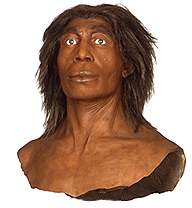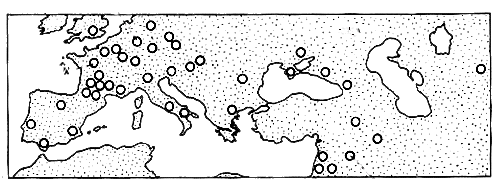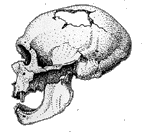Homo neanderthalensis

 Neanderthals lived roughly 150,000 to 30,000 years ago and lived in much of
Europe, part of Asia, and the Middle East. The first fossils humans to be discovered, Neanderthals have long been the focus of anthropological investigation. More bones of Neanderthals are known than for any other fossil hominine group, including some 30 nearly complete skeletons, so this preoccupation within the anthropological profession is understandable.
Neanderthals lived roughly 150,000 to 30,000 years ago and lived in much of
Europe, part of Asia, and the Middle East. The first fossils humans to be discovered, Neanderthals have long been the focus of anthropological investigation. More bones of Neanderthals are known than for any other fossil hominine group, including some 30 nearly complete skeletons, so this preoccupation within the anthropological profession is understandable.
Neanderthal anatomy represents a mixture of primitive characters, derived characters that are shared with other hominines, and derived characters that are unique to Neanderthals. In general terms, this species may be described as being robustly built, heavily muscled, and short in stature. Evidence of the heavy musculature appears in the extremely large muscle attachments and the bowing of the long bones. This implies that the species was involved in daily, routine, heavy work.
 This species existed in a cold climate, at the end of the Pleistocene Ice Age and this appears in the short forearm and leg relative to the humerus and femur (Allen�s rule which implies that in warm-blooded species, the relative size of the limbs decreases as temperature decreases).
This species existed in a cold climate, at the end of the Pleistocene Ice Age and this appears in the short forearm and leg relative to the humerus and femur (Allen�s rule which implies that in warm-blooded species, the relative size of the limbs decreases as temperature decreases).
As seen in the image below, these are the locations where most
Neanderthal findings have been done.

The Neanderthal DNA sequence falls outside the variation of modern human DNA.
Thus if Neanderthals had contributed to our genome (any interbreeding whatsoever),
it would be expected that modern-day individuals would express Neanderthals geno-
and phenotypes. A paper published in the Journal Cell in 1997 proves that
there is no overlap between modern-day
Homo sapiens and Homo neanderthalensis genes. After a long period of overlap in the same timescale, Neanderthals went extinct in a wave from East to West where the last Neanderthal remains were found in Zafarraya, Spain 27,000 years ago.


The main skull differences between Homo neanderthalensis and Homo sapiens are shown above. The skull on the left is the Neanderthal skull and the figure on the right illustrates the skull differences between the two species.
This table shows the morphological differences between Homo heidelbergensis and Homo neanderthalensis.
|
|
H. heidelbergensis |
H. neanderthalensis |
|
Height |
Roughly 1.5 metres |
1.5 � 1.7 metres |
|
Physique |
Robust, but "human" skeleton |
As H. heidelbergensis, but adapted for cold |
|
Cranial Volume |
1100 � 1400 cc |
1200 � 1750 cc |
|
Known Date |
400,000 � 100,000 |
150,000 � 30,000 |
|
Distribution |
Africa, Asia and Europe |
Europe and Western Asia |
|
Skull form |
Higher skull; face less protruding |
Reduced brow ridge; thinner skull; large nose: midface projection |
|
Jaws/Teeth |
Simliar to H. erectus, but teeth may be smaller |
Simliar to H. heidelbergensis; teeth smaller except for incisors; chin development in some |
Reference: Krings et al, 1997. Neanderthal DNA sequence and the origin of modern humans. Cell, 90, p. 19-30.
|
Ardipithecus ramidus
|
Australopithecus anamensis
|
Australopithecus afarensis
|
|
Australopithecus africanus
|
Australopithecus aethiopicus
|
Australopithecus boisei
|
|
Australopithecus robustus
|
Homo habilis
|
Homo rudolfensis
|
Homo erectus
|
Homo ergaster
|
|
Homo heidelbergensis
|
Homo neanderthalensis
|
Homo sapiens
|

 Neanderthals lived roughly 150,000 to 30,000 years ago and lived in much of
Europe, part of Asia, and the Middle East. The first fossils humans to be discovered, Neanderthals have long been the focus of anthropological investigation. More bones of Neanderthals are known than for any other fossil hominine group, including some 30 nearly complete skeletons, so this preoccupation within the anthropological profession is understandable.
Neanderthals lived roughly 150,000 to 30,000 years ago and lived in much of
Europe, part of Asia, and the Middle East. The first fossils humans to be discovered, Neanderthals have long been the focus of anthropological investigation. More bones of Neanderthals are known than for any other fossil hominine group, including some 30 nearly complete skeletons, so this preoccupation within the anthropological profession is understandable. This species existed in a cold climate, at the end of the Pleistocene Ice Age and this appears in the short forearm and leg relative to the humerus and femur (Allen�s rule which implies that in warm-blooded species, the relative size of the limbs decreases as temperature decreases).
This species existed in a cold climate, at the end of the Pleistocene Ice Age and this appears in the short forearm and leg relative to the humerus and femur (Allen�s rule which implies that in warm-blooded species, the relative size of the limbs decreases as temperature decreases).

